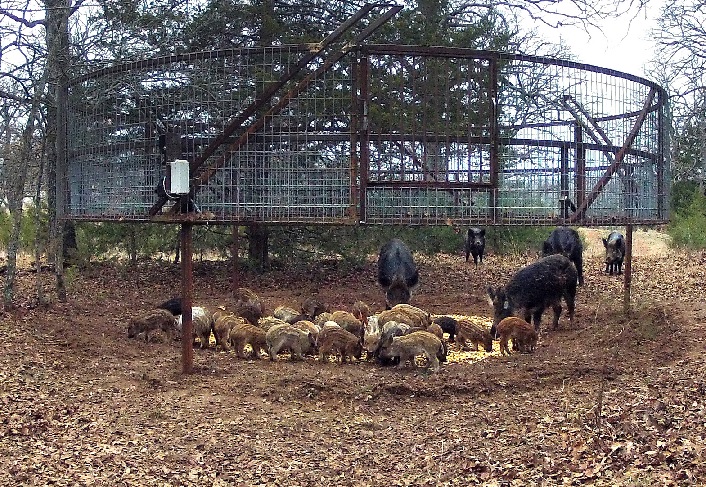
Agricultural News
Are Toxicants for Feral Hogs a Silver Bullet or Short Fuse? Probably Not, But There Are Alternatives
Mon, 01 May 2017 12:30:56 CDT
 The following is an article entitled Toxicants for Feral Hogs: Silver Bullet or Short Fuse? authored by Josh Gaskamp, Wildlife and Range Consultant, of the Samuel Roberts Noble Foundation.
The following is an article entitled Toxicants for Feral Hogs: Silver Bullet or Short Fuse? authored by Josh Gaskamp, Wildlife and Range Consultant, of the Samuel Roberts Noble Foundation.
During the last 30 years, new techniques and modifications to existing ones have continued in an effort to find a silver bullet to control feral hogs. Many landowners who repeatedly incur costly damage due to feral hogs question when a toxicant will become available. Some landowners believe a toxicant will be the silver bullet.
Currently, there are no approved poisons or toxicants legal for use on feral hogs in Texas or Oklahoma. However, state and federal agencies and the private sector are working persistently to change this. Why don't we have a toxicant yet? There are significant challenges with getting a new toxicant registered and approved. Lots of research and testing must be conducted to ensure there are minimal impacts to other animals, human health and the environment.
Challenges of Developing Toxicants
One big challenge in the development of a toxicant in the U.S. is making it species-specific. Efforts to reduce exposure to non-target animals are important to ensure the toxicant reaches feral hogs but not native wildlife, livestock, pets or humans. Researchers are testing feeders with weighted doors, even some with animal recognition software, to keep black bears and raccoons out.
Having this type of species-specific delivery system presents another challenge. Hogs are smart and often wary of man-made objects. If a weighted door must be lifted to remove the toxicant, a training period will be necessary to habituate hogs to the feeder, much like the habituation period that should take place when trapping with cage and corral traps.
Another challenge is bait aversion. Toxic baits may be tasteless, odorless, or have an undesirable taste or odor. In any case, hogs may not eat the bait if it is not masked by a desirable product. Additionally, if a hog gets a sub-lethal dose of the toxin, it may learn from the negative experience it had with the bait (i.e., getting sick).
One of the largest public concerns with using toxicants is the risk of secondary poisoning. Rats and mice are poisoned regularly but are not typically considered table fare like feral hogs. In addition, it takes much longer for a hog carcass to decompose than a rat, allowing more opportunity for scavenging animals to contact and consume poisoned animals. Most toxicants are also detrimental to fish.
Toxicants Under Consideration
Two toxicants that have previously been used in Australia to poison feral hogs are being considered for use in the U.S.
The United States Department of Agriculture Animal and Plant Health Inspection Service is working with researchers to register and approve sodium nitrite. Sodium nitrite is used in hog poison in Australia and is used as a food preservative in the U.S. (ironically in bacon). It causes methemoglobinemia in hogs, resulting in rapid depletion of oxygen to the brain and vital organs. Death occurs within 1.5 hours in feral hogs (Cowled et al. 2008a).
Kaput® is a warfarin-based bait that was eventually banned in Australia. Warfarin is a blood thinner that hogs are very susceptible to, dying within a few days of receiving a lethal dose. Texas Department of Agriculture (TDA) in collaboration with Scimetrics Ltd. Corporation worked to develop Kaput®. Kaput® has an Environmental Protection Agency (EPA)-approved label and is currently being considered for approval in several states. Immediately following TDA approval of Kaput® for restricted use in the state of Texas, legal action followed citing concerns to human health. Kaput® says they will have a commercial product available in May-June 2017 if its use is legal in any states.
Toxicants will not be the silver bullet landowners are looking for, but it will be another tool in the war on hogs. The Kaput® label has very specific protocols for habituating hogs with a mandatory feeder, disposing of carcasses, grazing restrictions and reporting of non-target kills. It will be extremely important for applicators of toxic baits to adhere to all requirements in any label approved by the EPA as well as any special restrictions imposed by a state. Misuse of any approved toxicant can result in damage to natural resources and result in the loss of a new tool for hog control.
Other Control Methods
Research suggests that suspended traps are one of the most effective and efficient techniques for capturing feral hogs.
Corral traps are one of the most popular techniques for capturing feral hogs. Most landowners can build their own trap. However, allowing feral hogs to become familiar with the trap over several days or weeks before trapping is important to be successful.
Hunting does not eliminate enough animals to control feral hog populations when used by itself. However, integrating hunting for hogs left behind after initial trapping efforts can contribute to population control.
WebReadyTM Powered by WireReady® NSI
Top Agricultural News
More Headlines...





